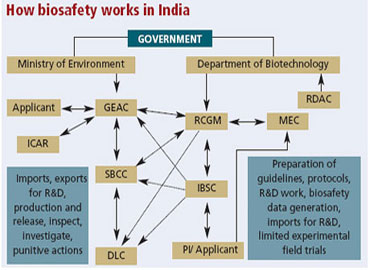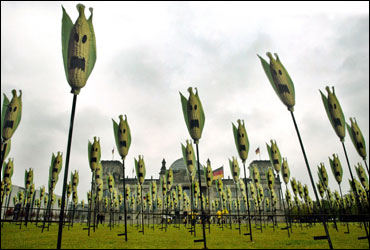 | « Back to article | Print this article |
The true story behind the GM mess
As India gets ready to unleash a vast number of genetically modified (GM) food crops, politicians have joined activists in opposing engineered crops.
This is snowballing into a volatile political issue with states refusing to let the Centre have the final say in the matter. A number of chief ministers have objected to field tests of GM crops being conducted in their backyard, while some have declared that their states will be GM-free, citing health and environmental concerns.
The political standoff comes against the worrying backdrop of slipshod regulation. Not only is illegal herbicide-tolerant cotton spreading across the country, biosafety regulations are being openly flouted by private crop developers acting in collusion with public research institutions.
At the same time the industry is demanding a dilution of the rules on field tests and other regulations.At daybreak on March 11, there was a burst of activity at Litchi Lawn, a corner plot on the sprawling campus of the Pusa Institute in Bihar's Samastipur district.
Workers were uprooting the maize growing in a small patch of land close to the office, intent on finishing their work quickly as they had been instructed.
The Pusa Institute is actually the old home of the Indian Agricultural Research Institute (IARI) whose headquarters has shifted to Delhi.
The 540-square-metre maize patch, surrounded by fields of wheat, mustard and cauliflower, and on the north by the institute's famous mango and litchi nursery, looked like any other experimental plot. But something was clearly not right.
After the maize was pulled out, tractors were brought in to level the land and moong, or green gram, was planted in its place.
Click NEXT to read on . . .
The true story behind the GM mess
What was uprooted so hastily that morning? It was genetically modified (GM) maize, an insect-resistant and herbicide-tolerant variety that had been developed by Monsanto.
The American biotech giant's Event MON 89034 and Event NK603 - every cell that successfully incorporates the gene of interest represents a unique 'event' and the derived transgenic line is identified by such figures - was being tested at several other locations.
It is still a puzzle why the Pusa trial was uprooted in such a rush and the plot replanted so quickly without due regard for contamination of the subsequent crop.
According to a Monsanto spokesperson, the regulator, the Genetic Engineering Appraisal Committee (GEAC), had sent them a letter withdrawing permission for the trial but before the company could respond, the IARI station at Pusa, acting on orders from its headquarters, had destroyed the trial.
A Pusa official told Down To Earth this was done because Bihar chief minister Nitish Kumar had told Minister of Environment and Forests Jairam Ramesh that he did not want any GM trial in his state and the latter had instructed GEAC to cancel the trial forthwith.
But in its rush to scrap the trial did IARI follow procedures with regard to destruction of GM crops?
Interestingly, it was Nitish Kumar himself who raised the issue. In a letter written to Ramesh three days after the event at Litchi Lawn, the chief minister pointed out that the maize trial had been "hurriedly uprooted in an unscientific manner and without the presence of any state agriculture representative".
Click NEXT to read on . . .
The true story behind the GM mess
He also raised concerns about other possible violations: did IARI Pusa have the required isolation distance in all directions to ensure that the pollen did not flow to other crops from the GM maize?
In any case the field trials were illegal because Bihar does not have the state biotechnology coordination committee or the district-level committee, both of which are charged with implementation of the regulations and overseeing the transgenic field trials in the states.
If this is the state of play with IARI, which is "the country's premier institute for research, education and extension", it is not difficult to imagine what is happening elsewhere.
As India becomes a vast testing ground for all kinds of GM crops, which policymakers believe will usher in the second Green Revolution for the country, there are clear indications that regulations are being thrown overboard as private crop developers and the National Agriculture Research System (NARS) join hands on the testing of GM crops.
The problem with India is that GM crop trials are being approved at dizzying speed - at one three-hour meeting, GEAC approved 144 applications - while little is done to monitor field trials, many of which are illegal because they do not comply with requirements.
Quite often, GEAC has been unaware of where the trials were being held.
Click NEXT to read on . . .
The true story behind the GM mess
The most egregious example of rules being flouted is the case of Maharashtra Hybrid Seeds Company (Mahyco), which defied the regulator and used an unapproved cotton hybrid as refugia for its third generation BG2 RRF cotton that was undergoing the second stage field tests in Maharashtra.
Refugia is the prescribed area where non-GM is grown so that the pests against which the GM trait is being introduced have non-toxic plants to feed on to delay the build-up of resistance to the GM toxin.
GEAC regulations stipulate that 20 per cent of the area has to be the refuge crop planted all round the field where the GM crop is undergoing tests.
What did Mahyco do? Although it had been denied permission to use non- BT Round Ready Flex (RRF) hybrids as refugia at the September 2010 meeting of GEAC because it had not been approved for environmental release, it coolly went ahead and produced the seed and used it as the refuge.
But Mahyco's explanation is that it did not flout the law; it only produced non-Bt RRF seed in greenhouse for field trial purposes, according to managing director Raju Barwale.
The field trials of Mahyco's BG2 RRF cotton are being supervised by the director of the public sector, Central Institute for Cotton Research (CICR) in Nagpur.
He has been defending the company which was first issued a show cause notice by GEAC and later a warning. K R Kranthi, CICR boss, says in his defence to GEAC: If only non- BT cotton without RRF was used, "there is every possibility of the refugia getting destroyed due to spray drift or inadvertent application of Roundup."
Roundup is the brand name of a broad-spectrum herbicide produced by Monsanto which contains the active ingredient glyphosate. Incidentally, Monsanto has a 26 per cent equity holding in Mahyco.
Click NEXT to read on . . .
The true story behind the GM mess
Plant geneticist and former academic Suman Sahai emphasises that this is not just a case of Mahyco cocking a snook at GEAC; the implications of Mahyco's use of the unauthorised refugia are far more serious for Indian agriculture.
"What it means is that planting a herbicide-tolerant (HT) crop, like the new Bt-HT cotton, and using the matched herbicide (Roundup) during its cultivation will destroy all the neighbouring crops and the adjoining biodiversity. This will happen when Roundup lands on them while fields of the HT crops are being sprayed. Only plants carrying the HT gene can survive the herbicide spray."
Sahai is convenor of Gene Campaign, which works to empower local communities to retain control over their genetic resources.
However, Barwale pooh-poohs such fears despite Kranthi's contention to the contrary before GEAC. Responding to queries from Down To Earth, Barwale says: "The fear that spray of the herbicide on such herbicide-tolerant crops will destroy adjoining crops and biodiversity are unfounded and not based on any scientific data."
He points out that herbicide-tolerant crops, including cotton, were cultivated worldwide over 89.3 million hectares in 2010.
"It is our view that BG II-RRF cotton will provide additional benefits to the large number of small and marginal farmers and the environment."
And what do the regulators have to say about violations that activists describe as flagrant? According to GEAC co-chairperson Arjula R Reddy, the regulator is pretty much powerless to do anything.
This explains why since field trials began in this country, illegalities have abounded here. The introduction of BT cotton in 2002 was preceded by the discovery that cultivation of illicit Bt was rampant in Gujarat, grown on 4,451 hectares.
The authorities showed a complete inability to deal with the situation and GEAC admitted at the time there were serious shortcomings in the regulatory system.
Click NEXT to read on . . .
The true story behind the GM mess
History is repeating itself - and with vengeance.
The country is now awash in illicit HT cotton and farmers in Gujarat have been growing the crop since 2006, if not earlier. Aruna Rodrigues, leader petitioner in a public interest litigation seeking a moratorium on GM testing in the country, has been campaigning ceaselessly with GEAC to halt the spread of the illegal HT cotton.
It has now spread to Madhya Pradesh and Andhra Pradesh, too.
She says the matter is of enormous concern because it has serious consequences for Indian agriculture and biodiversity, but so far the regulator has been unable to stop the spread.
On the other hand, GEAC has been liberal in authorising all kinds of new events, including the stacked GM maize with Bt and HT. Monsanto, in fact, has been allowed to take up seed production in 10 hectares.
Rodrigues, who has been writing to GEAC since June 2009 on the illegal HT stacked cotton, says the failure to rectify matters by the regulator citing ineffective laws is unacceptable.
"If laws have not been put into place after all these years to ensure strict compliance, all plantings of GMOs should be stopped."
But politicians like Nitish Kumar are not waiting for a stricter law to be put in place. They have already decided to say a firm no to GM testing and cultivation of any GM crop in their state.
Click NEXT to read on . . .
The true story behind the GM mess
Mullakkara Retnakaran, Kerala's agriculture minister, says, "We cannot permit open field trials until safety issues related to human and animal health and the environment have been comprehensively evaluated.
Kerala is a biodiversity hot spot and we cannot take risks."
Kerala declared itself a GM-free state last year. Madhya Pradesh too has followed suit and in a letter written to Ramesh last month Ramkrishn Kusumaria, minister for farmers' welfare and agriculture, said it would neither allow field trials nor any open releases.
Monsanto, meanwhile, is looking for an alternative site to the Pusa trials that were stopped. A spokesperson for the company says, "This unfortunate decision to stop the trials will be a setback for research and delay access of high-income-generating crop technologies to Indian farmers."
Nitish Kumar begs to disagree. He says maize, which is a major crop in Bihar, is doing very well.
Productivity is higher than the national average and the state turns out 1.7 million tonnes, contributing more than 60 per cent of the country's rabi production. As for the claimed advantages of GM maize, it has no relevance for Bihar.






